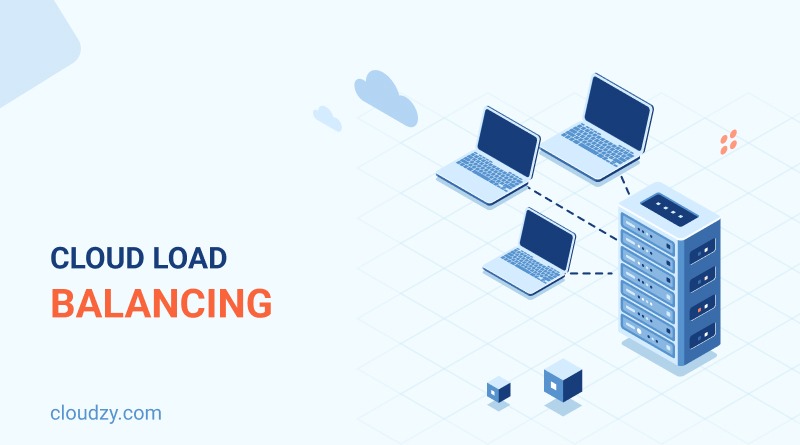Receiving substantial traffic to your website or application may be a blessing. However, without the necessary resources and architecture to manage this influx, it may also turn into a curse, leading to slowdowns or even downtime. That’s where load balancing comes in, as one of the best methods to avoid these performance issues is to integrate load balancing into your infrastructure.
A load balancer, which can be either a hardware device or a software solution, acts as the middleman, distributing incoming traffic evenly and efficiently across multiple servers. By doing so, it prevents any single server from becoming overwhelmed, providing a smoother experience for users. Unlike traditional hardware-based load balancers, cloud load balancing operates as a software-based solution, providing the flexibility and scalability needed to handle traffic spikes dynamically and cost-effectively in a cloud environment.
Understanding the Importance of Cloud Load Balancing
Before we delve into using a load balancer in cloud, it is important to briefly overview database clustering. Whether you use a tool like Kubernetes or built-in services of Amazon Aurora or Google Cloud Spanner, creating clusters of nodes allows you to have multiple instances of your applications in your database. Load balancing, then comes into play as the agent managing and balancing the structure of your cluster.
The first and most important task a cloud load balancing solution does is ensuring traffic coming to your website is distributed evenly across your cluster. This prevents nodes from becoming bottlenecks. Using a load balancer in cloud allows you to optimize resource use and avoid poor user experiences by minimizing latency and downtime.
Moreover, cloud load balancing uses health check mechanisms to detect failed nodes and remove them from the list of available options. Generally, load balancers in cloud offer basic health checks by periodically testing the availability and performance of each node in a cluster. This allows any cloud load balancing program software to automatically reroute traffic away from any unresponsive or failed nodes. Adaptive load balancing, on the other hand, can take this further by dynamically adjusting traffic based on real-time performance metrics and more intricate algorithms.
Cloud load balancing solutions provide a variety of algorithms and strategies that can be customized to optimize performance based on specific needs. Towards that end, the ideal configuration depends on factors like the architecture of your cluster and the nature and volume of incoming traffic. With options such as round-robin, least connections, and IP hash algorithms, these solutions allow for flexible, responsive traffic distribution to maintain efficient resource use, reduce latency, and ensure high availability tailored to your system’s demands. I will go through cloud load balancing algorithms later in this post.
Types of Cloud Load Balancing
There are multiple ways you can utilize load balancers in cloud, and each of them is designed to cater to different needs and scenarios. That said, choosing the right configuration for cloud load balancing depends on a bunch of factors, including infrastructure and, naturally, your goals.
Moreover, it’s pretty important to consider exactly what you want to get out of using a load balancer in cloud. For instance, are you looking for a solution to use your resources more efficiently? Or is it more vital to reduce latency and lag for your clients? Answering such questions can help you pick a cloud load balancing solution more effectively.
Internal vs External cloud load balancing
It’s best if we go through the differences of internal vs external cloud load balancing before diving into the main types. This differentiation plays a foundational role since both network load balancing and application load balancing can take advantage of both routes.
Internal Load Balancing: Typically used within a private network, this model is often responsible for routing traffic between backend resources like database servers or microservices. Plus, It keeps communication contained within the cloud infrastructure, which is a decent perk as it improves performance and, to some degree, guarantees security for internal processes. For instance, it may balance requests among database clusters to prevent bottlenecks.
External load balancing: External load balancing manages the traffic coming from the internet to your website or application. It ensures user requests are efficiently distributed across your nodes and servers to improve the end-user experience. Moreover, it can be done both regionally and globally. Geolocation-based routing allows users to connect to available servers closest to them to minimize latency and ping for a global audience.
Both internal and external load balancing use protocols like TCP (Transmission Control Protocol, which ensures reliable data delivery) or HTTPS. Based on the type of load balancer you choose, you can choose either to manage layer 7 or layer 4 traffic in the OSI (Open Systems Interconnection) model.
Application Load Balancers (ALBs)
Application Load Balancers are Layer 7 load balancers designed to route traffic based on application-level details such as HTTP headers, URLs, or request paths. it makes them a great option for web applications that require advanced request handling and routing based on content. Also, they’re proxy-based, meaning they terminate the client connection, process requests, and establish new connections to the backend servers.
These load balancers can handle HTTP and HTTPS traffic and support features like path-based routing (e.g., directing /api traffic to one server group and /static to another) and host-based routing.
Application Load Balancers can operate in internal or external modes:
- External Application Load Balancers handle traffic from the internet and can be deployed globally (across multiple regions) or regionally (within a single location).
- Internal Application Load Balancers are used for backend services within a private network, ensuring secure traffic distribution between resources in a VPC.
Their flexibility and integration with features like TLS termination, WebSocket support, and content-based routing make them ideal for modern microservices architectures or applications requiring tailored traffic management.
Network Load Balancers (NLBs)
Network Load Balancers (NLBs) are Layer 4 load balancers designed for high-performance traffic routing based on transport-level information such as IP addresses and ports. In cloud load balancing, they are particularly suited for handling large volumes of traffic with low latency and are ideal for scenarios that require high throughput or support for protocols beyond HTTP/S, such as UDP (User Datagram Protocol) or TCP (Transmission Control Protocol).
These load balancers are connection-oriented and do not inspect the content of requests, making them faster and more lightweight compared to Layer 7 load balancers. This makes NLBs a great fit for applications like real-time communications, video streaming, or gaming, where maintaining low latency is critical.
Network Load Balancers can be deployed in external or internal modes:
- External NLBs handle traffic originating from outside the cloud environment, balancing the load across backend services while preserving client IPs, which is beneficial for logging or security purposes.
- Internal NLBs operate within a Virtual Private Cloud (VPC) to manage traffic between internal services, such as database clusters or backend applications.
Moreover, Network Load Balancers support TLS offloading for encrypted traffic, reducing the computational burden on backend servers by decrypting data at the load balancer level. Their simplicity and speed make them a robust choice for handling traffic at the network layer.
Cloud Load Balancing Algorithms
these algorithms are categorized into two main types: dynamic and static. As for their function, let’s start with dynamic algorithms.
For load balancers in cloud, dynamic algorithms adjust traffic distribution in real-time based on factors like server load or response times. For example, Least Connection makes sure that new requests are assigned to the server with the fewest active connections, helping to balance workloads a lot better. Another example would be Weighted Response, which prioritizes servers with faster response times, giving you the benefit of optimal performance for time-sensitive applications.
These adaptive methods are ideal for dynamic environments where traffic and server conditions fluctuate regularly.
On the other hand, static algorithms follow fixed rules, distributing traffic in predefined patterns without considering real-time server performance. A popular static algorithm is Round Robin, which sequentially assigns requests to servers. While simple and predictable, static methods are better suited to scenarios with evenly matched server capabilities and consistent traffic.
There are additional subcategories within each type, like IP Hash for static configurations or Dynamic Least Loaded for dynamic balancing. Each method serves specific needs, from minimizing latency to optimizing resource usage.
For a comprehensive exploration of these algorithms and their use cases, check out our detailed post on load balancing algorithms.
Want a high-performance Cloud VPS? Get yours today and only pay for what you use with Cloudzy!
Get Started HereHow Cloud Load Balancing Improves Performance and Reliability
There are many benefits to using a load balancer in cloud that can help you ensure everything runs as optimal as possible and your resources are used efficiently. Some of the advantages of using a load balancer in cloud:
Scalability
A load balancer in cloud adjusts resources dynamically to meet traffic demands. For example, an e-commerce website can handle seasonal spikes without requiring additional hardware, ensuring smooth operations.
Global Reach
One pretty significant perk load balancing offers is that, by directing users to the nearest server, it reduces latency by quite a bit. For instance, users in Europe are expectedly routed to a European server, which speeds up access and, in doing so, enhances user experience.
Cost Efficiency
You might be thinking that such software must cost a pretty penny, but with pay-as-you-go pricing models, cloud load balancing avoids the expense of maintaining unused resources, helping businesses optimize operational costs.
Improved Reliability
Reliability is a cornerstone in anything even remotely related to the internet, and regular health checks by a load balancer in cloud detect and exclude unhealthy servers, preventing downtime and maintaining consistent service availability.
Enhanced Application Performance
As you can already guess, cloud load balancing avoids overloading any single resource, which is pretty important, as it results in a reduction of response times and the management speed for applications and websites. This is done by distributing requests across multiple servers.
Final Verdict
To ensure optimal performance, reliability, and scalability, cloud load balancing is essential for modern applications. By dynamically distributing traffic across servers, it prevents downtime, reduces latency, and adapts to changing workloads seamlessly. Whether managing internal backend systems or delivering a global user experience, cloud load balancing empowers businesses to meet demand efficiently and cost-effectively.
With its range of algorithms, deployment options, and health checks, a load balancer in cloud is a vital tool for organizations aiming to enhance resource utilization and user satisfaction.
For businesses who want to benefit from all the advantages of a robust cloud environment, Cloudzy’s Cloud VPS is the ultimate solution. Our services come with 24/7 support and a 99.95% uptime guarantee, alongside a cost-effective pay-as-you-go model that allows you to cut all the unnecessary costs. This way, you can have a robust and responsive infrastructure at a minimum cost.
FAQ
What is cloud load balancing in GCP?
Cloud load balancing in Google Cloud Platform (GCP) is a managed service that automatically distributes incoming traffic across multiple servers, ensuring high availability and optimal performance for your applications.
How does cloud load balancing work?
Cloud load balancing uses algorithms and health checks to distribute traffic efficiently, routing requests to healthy servers based on factors like proximity, load, or server capacity.
Why is a load balancer needed?
A load balancer prevents server overload, ensures uninterrupted service, improves user experience by reducing latency, and enhances application reliability.




